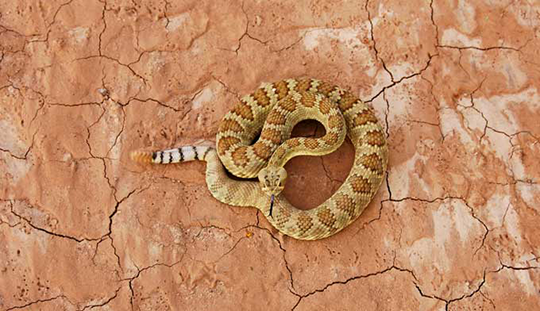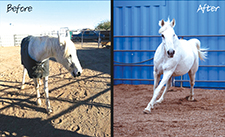
April 13, 2016
Rattlesnake Season Is Here!

There are many misconceptions about rattlesnakes and treating their bites. Keep yourself and your pet safe: learn some facts and fallacies about rattlesnakes.
1. Fallacy: Rattlesnake bites are always fatal. In the United States, only about 10 to 12 people die each year from snake bites. In Arizona alone, there are about 100 snake bite cases per year.
2. Fallacy: Baby rattlesnakes are more toxic than adults. Many people believe this fallacy because baby snakes do tend to inject their venom every time they strike, since they have not yet learned what they can and can’t eat. Older, wiser snakes only envenomate when they can eat the prey and when their attackers don’t learn after the first strike. But baby rattlesnake venom isn’t more toxic.
3. Fallacy: Dogs and cats do not need treatment for snake bites. It is true that a percentage of animals will survive snake bites without receiving treatment. But why leave it up to chance? Approximately 20% of all snake bites are “dry bites.” This means no envenomation (injection of venom) occurs. The remaining 80% of bites do inject venom. There are three possible outcomes when venom is injected:
a. A small percentage of animals will die.
b. Around 40% of animals will get better eventually, but they will be severely sick for anywhere between a couple of days to a few weeks.
c. Some pets will not only be very sick, but the tissue around the bite will also die and slough (fall off). Often, to treat this, the pet must receive reconstructive surgery and/or a month of rehab to regrow the dead tissue.
We don’t know right away whether the animal will be in the 40% that survives with no issues or in the 60% that will have serious health problems.
4. Fallacy: The only treatment needed is a little cortisone. Otherwise, my pet will be fine. The truth is, 40% of animals that are bit by snakes will get better no matter what you do. Many people attempt home remedies, like passing electricity through the wound, cutting an X over the wound and sucking out the venom, or, my favorite, tying garlic around your pet’s neck and pointing him or her south. The best treatment, which has the most predictable results, is to provide antivenom and intravenous fluids. The only downside: antivenom is very expensive. Depending on the type used, it can cost between $650 and $1,000.
5. Fallacy: Rattlesnakes will chase you and can jump 10 feet. Rattlesnakes are very docile creatures; in fact, they are more scared of you than you are of them. There is only one problem with this: they can’t outrun you, so when they feel threatened, they will stay and fight. When threatened, rattlesnakes coil up so they can cover more distance when they strike. However, this distance is never more than one-third to one-half of the length of their bodies.
6. Fallacy: You should cut the rattlesnake fang mark in an X and suck out the venom. This does not work, and worse, it can make the person sucking out the venom very sick. Once your pet is bitten, venom spreads very rapidly into the body, so you cannot suck enough venom out to make a difference. Also, if you attempt to suck out the venom and have a sore in your mouth or stomach, you can have similar symptoms to the animal that was bitten.
Other methods, like icing the area or applying tourniquets, are also commonly suggested. These are also ineffective and may be detrimental. Anytime you slow blood flow to an envenomated area, the venom becomes more concentrated, causing more tissue damage.
7. Fallacy: Rattlesnakes are only a threat during the day. Actually, rattlesnakes can be a threat day or night. Their activity is more associated with environmental temperature. Rattlesnakes are most active when the temperature is between 75⁰F and 90⁰F. At cooler temperatures, you will likely see snakes sunning themselves in the road or on rocks. At warmer temperatures, you will find rattlesnakes in the shade, under bushes and near water.
Dr. Cliff Faver is the founder of Animal Health Services. Visit ahsvet.com or call 480.498.4480.
April 13, 2016
Donkey update from Triple R Horse Rescue
We are so grateful for all of the inquiries about the donkeys that are coming into Triple R Horse Rescue. Due to receiving more than 300 applications for 20 donkeys, new applicants will not be considered.
The donkey's arrival date has been postponed several more weeks, and we will need extra time to accurately assess them before we can adopt them out properly. Additionally, it will require time for us to address any of their medical needs.
As they have not been handled, the donkeys will not be able to go to their forever homes until they have been fully assessed and have been handled enough to be considered safe.
We will hold a lottery drawing on April 20, 2016, then an email will be sent to all applicants showing the winners. The winners will also receive a contract, which they will be required to review and document in writing that they agree to all the terms and conditions.
To those NOT drawn, please do not call or email us requesting to be considered if any of the chosen cannot complete the process, or to be considered if we get additional donkeys. This will be automatic.
In addition, please do not come to the rescue unless you have an appointment. We will be holding an open house, as well as some media opportunities.
We are doing everything in our power to ensure this entire process goes as quickly and SAFELY as possible. Please know that we are dedicated to ensuring that the donkeys are correctly placed, and we are 100% volunteer run organization so this process will take a little longer to complete.
Thank you from the bottom of our hearts to everyone who inquired about the donkeys and to everyone who continues to support Triple R. Because of your generosity and support we are able to give these donkeys a second chance at a better life.


